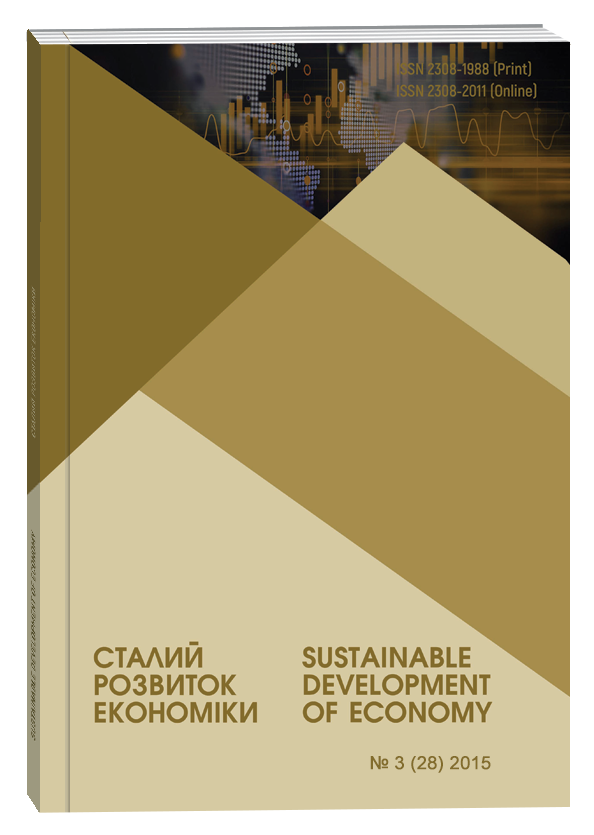CURRENT TRENDS IN THE FORMATION AND USE OF INTERNATIONAL RESERVES
Abstract
Purpose. The study aims to clarify the concept of reserves and their purpose, the study of modern trends in the formation of international reserves. Methodology of research. Theoretical and methodological basis of the study were scientific works of domestic and foreign scientists on issues related to the management of official reserves. The study used general scientific and special methods of scientific knowledge, in particular: abstraction and logical analysis (to clarify the nature of foreign exchange reserves management process and functions), correlation and regression analysis (to predict the dynamics of reserves). Findings. Specified the concept of reserves, systematized views of different scientists on purpose of international reserves. Analyzed current trends in the formation of international reserves, on the basis of correlation-regression analysis of the dynamics FX reserves forecast is done. Origanality. Specified the essence of the concept of reserves, analyzed current trends of foreign reserves accumulation and the forecast of their dynamics is done. Practical. The obtained results of the study can be used in the formation of investment management declarations of FX reserves.
References
Aizenman J., Cheung Y.-W., Ito H. International Reserves Before and After the Global Crisis: Is There No End to Hoarding? // NBER Working Paper. – 2014. – No. 20386. [Electronic resource]. – Access mode: http://www.nber.org/papers/w20386.pdf
International reserves : IMF concerns and country perspectives / [prepared by an IEO team led by Hans Genberg]. – Washington, D.C. : International Monetary Fund, 2012. [Electronic resource]. – Access mode: http://www.ieo-imf.org/ieo/files/completedevaluations/IR_Main_Report.pdf
Козюк В.В. Монетарні засади глобальної фінансової стабільності : монографія / В.В. Козюк. – Тернопіль : ТНЕУ, 2009. – 725 с.
Obstfeld M., Shambaugh J. C., Taylor A. M. Financial Stability, the Trilemma, and International Reserves. // NBER Working Paper. – 2008. – №14217 [Electronic resource]. – Access mode: http://www.nber.org/papers/w14217
Дзюблюк О.В. Валютна політика : підручник / О.В. Дзюблюк. – К. : Знання, 2007. – 422 с.
Стельмах В.С. Монетарна політика Національного банку України: сучасний стан та перспективи змін / В.С. Стельмах. – К. : Центр наукових досліджень НБУ, 2009. – 404 с.
Центральний банк та грошово-кредитна політика : підручник / А.М. Мороз, М.Ф. Пуховкіна, М.І. Савлук та ін. – К. : КНЕУ, 2005. – 556 с.
Косова Т.Д. Центральний банк і грошово-кредитна політика / Т.Д. Косова, О.О. Папаіка та ін. – К. : Центр учбової літератури, 2011. – 328 с.
Balance of payments and international investment position manual. Sixth Edition. Washington,
D.C., 2009. – International Monetary Fund. – 351 p. [Electronic resource]. – Access mode: http://www.imf.org/external/pubs/ft/bop/2007/pdf/bpm6.pdf.
Карбау Р. Міжнародна економіка / Р. Карбау. – Суми: Козацький вал, 2004. – 652 с. 11.Офіційний сайт Світового банку [Електронний ресурс]. – Режим доступу : http://data.worldbank.org/indicator/all
Global Economic Prospects 2015: Having Fiscal Space and Using It. Washington, DC: World Bank, 2015. [Electronic resource]. - Access mode: https://www.worldbank.org/en/publication/global-economic- prospects/summary-table
Aizenman, J., Cheung, Y.-W., Ito, H. (2014), International Reserves Before and After the Global Crisis: Is There No End to Hoarding? NBER Working Paper, available at: http://nber.org/papers/w20386.pdf
IMF (2012), International reserves: IMF concerns and country perspectives, [prepared by an IEO team led by Hans Genberg], Washington, available at: http://ieo- imf.org/ieo/files/completedevaluations/IR_Main_Report.pdf
Koziuk, V.V. (2009), Monetarni zasady hlobalnoi finansovoi stabilnosti [Monetary foundations of global financial stability], TNEU, Ternopil, 725 p.
Obstfeld, M., Shambaugh, J.C. and Taylor, A.M. (2008), Financial Stability, the Trilemma, and International Reserves, NBER Working Paper №14217, available at: http://nber.org/papers/w14217
Dziubliuk, O.V. (2007), Valiutna polityka [Monetary policy], Znannia, Kyiv, Ukraine, 422 p.
Stelmakh, V.S. (2009), Monetarna polityka Natsionalnoho banku Ukrainy: suchasnyi stan ta perspektyvy zmin [The monetary policy of the National Bank of Ukraine: Current State and Prospects of changes], Tsentr naukovykh doslidzhen NBU, Kyiv, Ukraine, 404 p.
Moroz, A.M., Pukhovkina, M.F. and Savluk, M.I. (2005), Tsentralnyi bank ta hroshovo-kredytna polityka [The Central Bank and monetary policy], KNEU, Kyiv, Ukraine, 556 p.
Kosova, T.D. and Papaika, O.O. (2011), Tsentralnyi bank i hroshovo-kredytna polityka [The Central Bank and monetary policy], Tsentr uchbovoi literatury, Kyiv, Ukraine, 328 p.
IMF (2009), Balance of payments and international investment position manual, Washington, 351 p., available at: http://http://imf.org/external/pubs/ft/bop/2007/pdf/bpm6.pdf.
Karbau, R. (2004), Mizhnarodna ekonomika [International Economics], Kozatskyi val, Sumy, Ukraine, 652 p.
The World Bank official site [WWW resource], available at: http://data.worldbank.org/indicator/all
World Bank (2015), Global Economic Prospects 2015: Having Fiscal Space and Using It, Washington, available at: https://worldbank.org/en/publication/global-economic-prospects/summary-table


